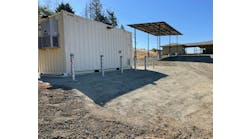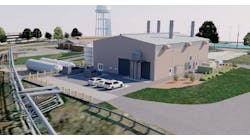Pennsylvania is the now the center of a pivotal, national industry debate over who pays for utility microgrids, with the introduction of legislation into the General Assembly that gives utilities a path to recover costs.
HB 1412 allows utilities to recover costs within customer rates for microgrids and energy storage projects. Rep. Stephen Barrar, a Republican from Chadds Ford, recently introduced the bill into the Committee on Veterans Affairs and Emergency Preparedness.
Should it pass, the legislation could become a model for other states grappling with the utility role in microgrid development.
“I can guarantee that other utilities across the country are looking at this,” said David Chiesa, senior director of business development at S&C Electric. “This has the potential to be a huge step change in the market.”
The issue is bubbling in states nationwide as the energy industry tries to wedge utility microgrids and energy storage into a regulatory framework that was designed before the technologies were anticipated.
Saying that such confusion blocks market growth, the microgrid industry and its investors are hungry for clarity.
“I can guarantee that other utilities across the country are looking at this.” — David Chiesa, S&C
Vote of confidence
Chris King, chief regulatory officer for Siemens Digital Grid, said that the bill arrives at “a critical juncture in the evolution of the microgrid and energy storage markets.”
“Because these markets are still emerging, the vote of confidence this legislation would provide is an important step in growth and expansion of the market,” King said. “It would build on efforts in other states, including New York and California, ultimately leading to cost reductions, product improvements, and more widespread availability and use.”
The crux of the rate issue is who benefits from utility microgrids and therefore who should pay for them. A microgrid offers direct services – reliability, price arbitrage, efficiency, clean energy – to those customers within its footprint. Some argue that those who receive the direct benefits — and not all ratepayers — should cover the microgrids cost.
Others, however, say that utility microgrids also can provide broader public and electric system benefits that warrant cost recovery through rates. For example, microgrids can serve as a refuge for the public during storms and power outages, creating electrified shelters or places for community members to charge phones, fuel cars or buy food.
In addition, utility microgrids can be strategically located on the grid to ease congestion, help integrate renewables, strengthen grid reliability or provide other services that lower the overall cost of operating the system. In such cases, microgrids benefit all ratepayers. When other forms of infrastructure — such transmission and distribution improvements — achieve such benefits, regulators allow utilities to recover their costs.
“…a critical juncture in the evolution of the microgrid and energy storage markets.” — Chris King, Siemens
Where utility microgrids serve the public interest
The Pennsylvania bill would allow utilities to recover costs of microgrids in rates if they prove to be “reasonable, prudently incurred expenses to operate and maintain the facility.”
The bill says that microgrids would prove to be in the public interest if they:
- Facilitate the diversity of electric supply options, including the addition of distributed energy
- Enhance the grid’s electric distribution, resiliency and operational flexibility
Should the bill pass, Pennsylvania utilities would be able to build a microgrid for customers in areas where electric reliability is low, knowing their costs will be covered, said S&C’s Chiesa. “It’s good for the utility, it’s great for the consumer, it’s good for the microgrid market.”
Justin Day, senior marketing program manager at Schweitzer Engineering Laboratories (SEL), says that the bill’s approach ensures that “everyone has some skin in the game, and everyone will get their fair share.”
“Determining who benefits and how much from a microgrid can be a deal breaker,” Day said. “The bill outlines some guidelines to identify how companies can recover microgrid costs while also ensuring that customers receive participation credits. Collaborative benefits like this promote buy-in from all stakeholders.”
…”everyone has some skin in the game, and everyone will get their fair share.” — Justin Day, SEL
What other states have done
Only a handful of other jurisdictions have taken on the problem. Maryland regulators last year turned down a request by Baltimore Gas & Electric, which proposed building microgrids contingent upon approval of cost recovery. Lawmakers in Illinois rejected legislation that would have allowed Commonwealth Edison to do the same. In Arizona and elsewhere utilities have decided to go forward with microgrids and take the risk that state regulators will approve cost recovery afterward.
Brian Levite, senior manager of business development at Hitachi America – Energy Solutions Division, said that “at the end of the day, the worst thing we can face is a lack of clarity around the regulations and fees associated with microgrids. Once every state has clearly laid out the rules of the game, assuming they do so in a way that doesn’t make development of distributed energy resources impossible, we developers will figure out the best way to play by those rules.”
The issue came to the fore last year in Pennsylvania when PECO Energy proposed microgrids for a high-density neighborhood with an 8.6 MW load. When the proposal ran into opposition before the Pennsylvania Public Utility Commission, PECO withdrew its application and convened a stakeholder collaboration to work out differences.
Ben Armstrong, PECO spokesman, said yesterday that the utility is analyzing results of the stakeholder feedback and deciding how best to proceed. PECO supports HB 1412, he said.
“…the worst thing we can face is a lack of clarity around the regulations” — Brian Levite, Hitachi
Other options for utilities
“Other states (NY, CA, DC, MD, MA) are taking much broader views of the opportunities offered by storage and microgrids. One would hope for legislation that offered non-discriminatory encouragement to all of the possibilities,” said C. Baird Brown, an attorney with Drinker Biddle & Reath and counsel to the Microgrid Resources Coalition.
“Other states (NY, CA, DC, MD, MA) are taking much broader views…” — C. Baird Brown, MRC
For example, New York, with its Reforming the Energy Vision (REV), is trying to get at the ratepayer equity problem in a way that is more comprehensive, and puts development of microgrids more in the hands of competiive companies than utilities. But the process also is slow to develop because of its complexity. REV entirely revamps the utility regulatory structure and makes utilities into administrators of a market platform on which microgrids and other distributed energy resources would compete.
Baird said that utility ownership and operation of microgrids can raise conflicts. For example, a utility must operate its assets to optimize performance of its system for all customers (all customers are paying for them). So, it cannot operate to optimize performance on behalf of the individual customer, he said.
It’s not yet clear how HB 1412, a bipartisan bill, will fare as it goes through the legislative process in Pennsylvania. Republicans hold the majority in the General Assembly and the primary sponsor, along with several co-sponsors, are Republican.
Titled, “An Act amending Title 66 (Public Utilities) of the Pennsylvania Consolidated Statutes, in restructuring of electric utility industry, providing for microgrid and energy storage,” the bill is available on the General Assembly website.
What’s your take on cost recovery for utility microgrids? Post your comments below or on our LinkedIn Group, Microgrid Knowledge.






